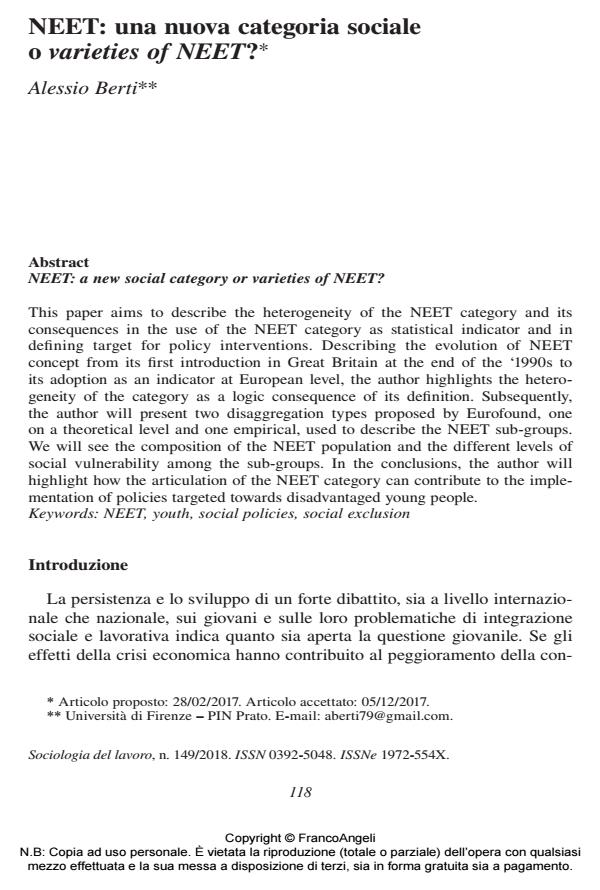NEET: a new social category or varieties of NEET?
Journal title SOCIOLOGIA DEL LAVORO
Author/s Alessio Berti
Publishing Year 2018 Issue 2018/149
Language Italian Pages 16 P. 118-133 File size 111 KB
DOI 10.3280/SL2018-149008
DOI is like a bar code for intellectual property: to have more infomation
click here
Below, you can see the article first page
If you want to buy this article in PDF format, you can do it, following the instructions to buy download credits

FrancoAngeli is member of Publishers International Linking Association, Inc (PILA), a not-for-profit association which run the CrossRef service enabling links to and from online scholarly content.
This paper aims to describe the heterogeneity of the NEET category and its consequences in the use of the NEET category as statistical indicator and in defining target for policy interventions. Describing the evolution of NEET concept from its first introduction in Great Britain at the end of the ‘1990s to its adoption as an indicator at European level, the author highlights the heterogeneity of the category as a logic consequence of its definition. Subsequently, the author will present two disaggregation types proposed by Eurofound, one on a theoretical level and one empirical, used to describe the NEET sub-groups. We will see the composition of the NEET population and the different levels of social vulnerability among the sub-groups. In the conclusions, the author will highlight how the articulation of the NEET category can contribute to the implementation of policies targeted towards disadvantaged young people.
Keywords: NEET, youth, social policies, social exclusion
- Tempi difficili. Le condizioni occupazionali degli early school leavers in Italia prima e dopo la crisi Camilla Borgna, Emanuela Struffolino, in SOCIOLOGIA DEL LAVORO 155/2019 pp.179
DOI: 10.3280/SL2019-155009 - Ricerche in corso Cinzia Angelini, Andrea Tinterri, Luigi Tinella, Andrea Bosco, Isabella Loiodice, Anna Dipace, Gabriella Agrusti, Valeria Damiani, Alberto Fornasari, Matteo Conte, in CADMO 1/2022 pp.99
DOI: 10.3280/CAD2022-001007
Alessio Berti, NEET: una nuova categoria sociale o varieties of NEET? in "SOCIOLOGIA DEL LAVORO " 149/2018, pp 118-133, DOI: 10.3280/SL2018-149008